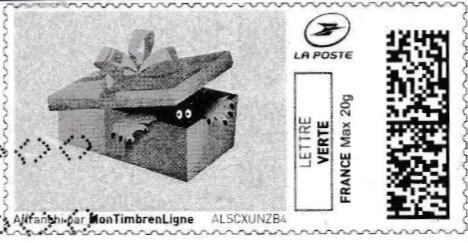Stamp: Surprise Gift. Mole Emerging from a box (France 2019)
Surprise Gift. Mole Emerging from a box (France 2019)
01 January (France ) within release MontimbrEnLigne. Celebrations goes into circulation Stamp Surprise Gift. Mole Emerging from a box face value Lettre No Face Value
| Stamp Surprise Gift. Mole Emerging from a box in catalogues | |
|---|---|
| Colnect codes: | Col: FR-TIM 2019-34b |
Stamp is square format.
Also in the issue MontimbrEnLigne. Celebrations:
- Stamp - Fantastic Cat 2 Merry Christmas. Joyeuses Fetes face value Lettre;
- Stamp - Fantastic Owl 2 Merry Christmas. Joyeuses Fetes face value Lettre;
- Stamp - Fantastic Reindeer 2 Merry Christmas. Bonnes Fetes face value Lettre;
- Stamp - Birthday, Anniversaire, pink background face value Lettre;
- Stamp - Merry Christmas Joyeux Noel in pink face value Lettre;
- Stamp - Tree and Gifts. Happy Christmas. Joyeux Noel in black face value 0.65;
- Stamp - Happy Christmas. Bear. Joyeuses Fetes in black face value Prioritaire;
- Stamp - Pretty Happy New Year. Bonne Annee in black face value Ecopli;
- Stamp - Three Baubles. Best Wishes. Meilleurs Voeux in black face value Ecopli;
- Stamp - Fantastic Reindeer 2 Merry Christmas. Bonnes Fetes face value Lettre;
- Stamp - Pretty Happy New Year. Bonne Annee face value Lettre;
- Stamp - Gold Fish Wearing a Sharks Fin in black face value 0.70;
- Stamp - Happy New Year. Fox. Heureuse Annee face value Lettre;
- Stamp - Aucune Resolution en 2019 in black face value Lettre;
- Stamp - Five Candles Happy Christmas. Bonnes Fetes in black face value Lettre;
- Stamp - Head of Fantastic Bear. Joyeux Noel in black face value Lettre;
- Stamp - One tree and five presents. Joyful Christmas. Joyeux Noel face value Lettre;
- Stamp - Surprise Gift. Mole Emerging from a box face value Lettre;
- Stamp - Happy New Year. Fox. Heureuse Annee in colour face value Lettre;
- Stamp - I Please Myself En 2019 Je me Fais Plaisir. in black face value Lettre;
- Stamp - Tail. Happy Christmas. Joyeux Noel in black face value Ecopli;
|
Data entry completed
46%
|
|
|---|---|
| Stamp Surprise Gift. Mole Emerging from a box in digits | |
| Country: | France |
| Date: | 2019-01-01 |
| Emission: | Personalized - Official |
| Format: | Stamp |
| Face Value: | Lettre No Face Value |
Stamp Surprise Gift. Mole Emerging from a box it reflects the thematic directions:
Animals are multicellular, eukaryotic organisms of the kingdom Animalia (also called Metazoa). All animals are motile, meaning they can move spontaneously and independently, at some point in their lives. Their body plan eventually becomes fixed as they develop, although some undergo a process of metamorphosis later on in their lives. All animals are heterotrophs: they must ingest other organisms or their products for sustenance.
The mole (symbol mol) is a unit of measurement, the base unit in the International System of Units (SI) for amount of substance, an SI base quantity proportional to the number of elementary entities of a substance. One mole is an aggregate of exactly 6.02214076×1023 elementary entities (approximately 602 sextillion or 602 billion times a trillion), which can be atoms, molecules, ions, ion pairs, or other particles. The number of particles in a mole is the Avogadro number (symbol N0) and the numerical value of the Avogadro constant (symbol NA) expressed in mol-1. The value was chosen on the basis of the historical definition of the mole as the amount of substance that corresponds to the number of atoms in 12 grams of 12C, which made the mass of a mole of a compound expressed in grams, numerically equal to the average molecular mass or formula mass of the compound expressed in daltons. With the 2019 revision of the SI, the numerical equivalence is now only approximate but may be assumed for all practical purposes.
A gift or a present is an item given to someone, without the expectation of payment or anything in return. An item is not a gift if that item is already owned by the one to whom it is given. Although gift-giving might involve an expectation of reciprocity, a gift is meant to be free. In many countries, the act of mutually exchanging money, goods, etc. may sustain social relationship and contribute to social cohesion. Economists have elaborated the economics of gift-giving into the notion of a gift economy. By extension, the term gift can refer to any item or act of service that makes the other happier or less sad, especially as a favour, including forgiveness and kindness. Gifts are often presented on occasions such as birthdays and holidays.


